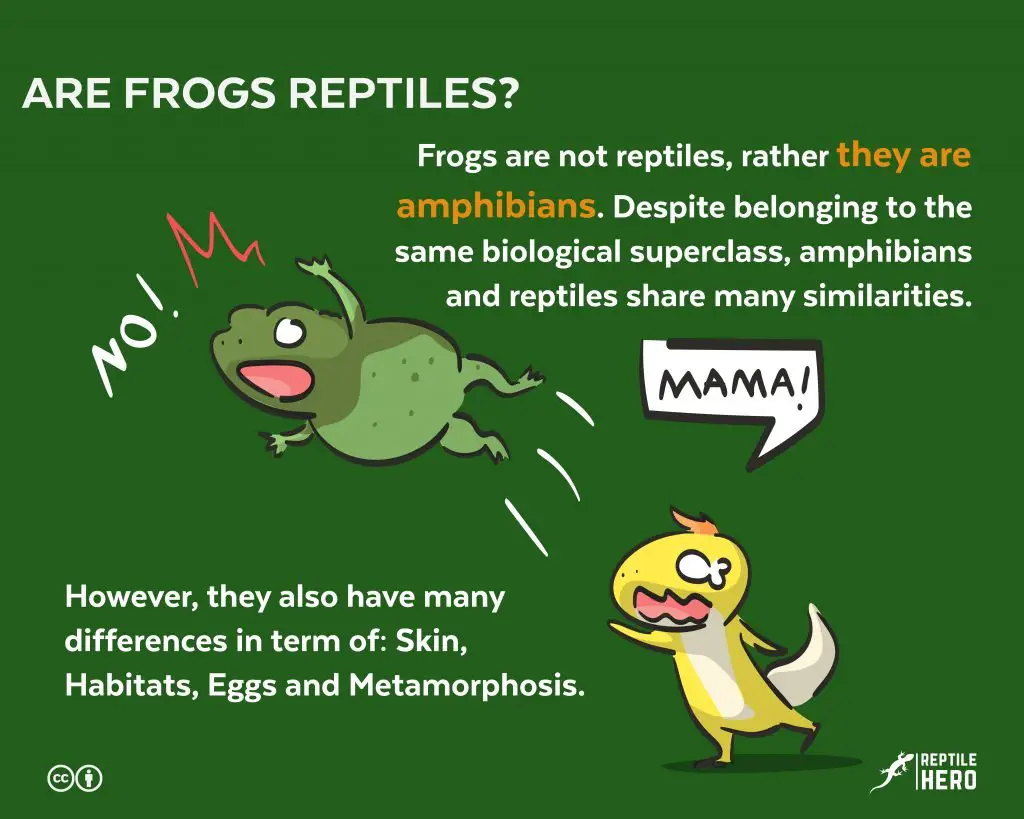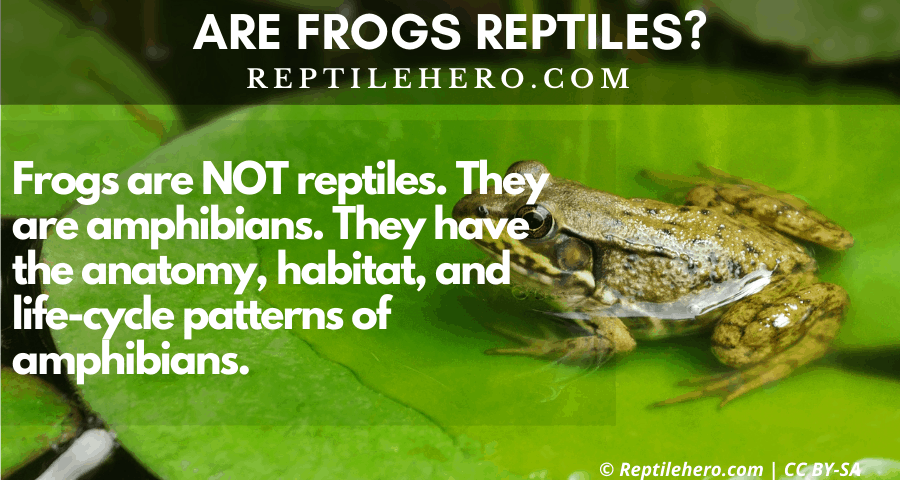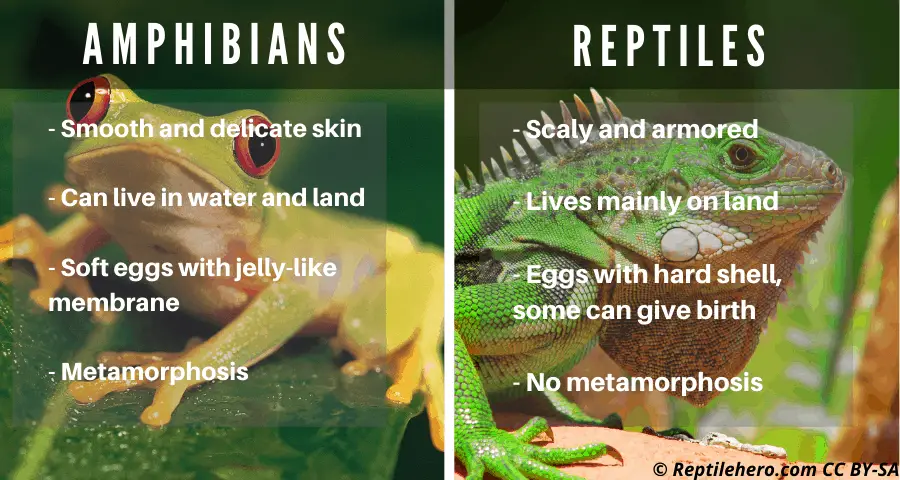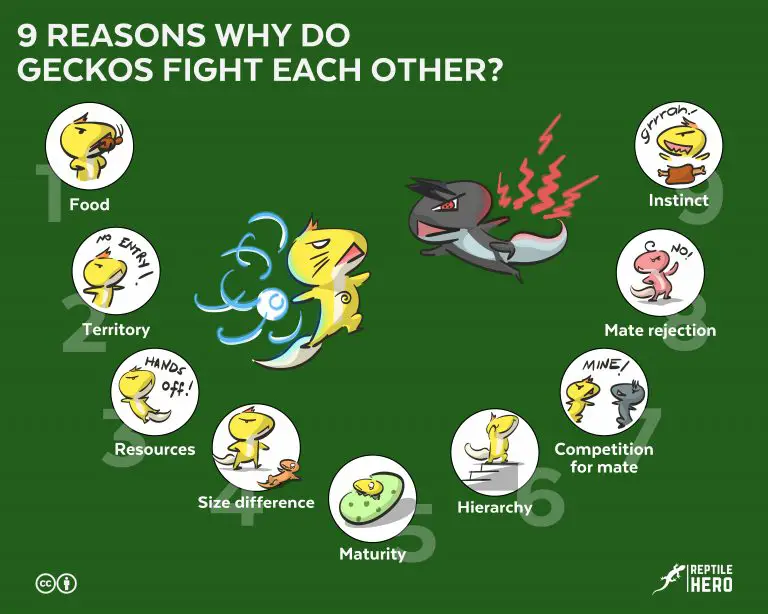Are Frogs Reptiles? All You Need to Know
Frogs make for unique and interesting pets. As exotic, wide-eyed, and generally slimy creatures, these guys would usually grab quite the attention, and often during those times, a good number of us would make the mistake of calling them reptiles.

Frogs are not reptiles, rather they are amphibians. Despite belonging to the same biological superclass, amphibians and reptiles share many similarities. However, they also have many differences in term of:
- Skin
- Habitats
- Eggs
- Metamorphosis
Read on as we talk about these differences in more detail.
How Are Frogs Amphibians?

Despite sharing many similarities, reptiles and amphibians differ from one another in a lot of ways discussed below:
| Feature | Amphibians | Reptiles |
|---|---|---|
| Skin | delicate and porous | scaly and armored |
| Habitat | water and land | mainly thrive in land and dry habitats |
| Eggs | soft, jelly-membraned eggs in water where they are fertilized externally | lay hard-shelled eggs on land or give birth to their young |
| Metamorphosis | go through the process of metamorphosis, existing in larval stages before developing into their adult form | hatched or born with their long-term physical structure |
The first major difference to look out for is each group’s habitat. As its Greek etymology suggests (amphi- means “of both kinds” and -bios means “life”), amphibians are known for having “dual lives” — in larvae form, they spend half their lives in water until they grow into more developed stages and become able to live in land as well.

Meanwhile, reptiles are known to be terrestrial beings, as they spend the bulk of their lives on dry land. Unlike amphibians, reptiles do not undergo metamorphosis and thus do not have larval stages in their life-cycle. When reptiles are born or hatched, they come out with the same shape and structure as their parents and mostly only grow larger as they age.
In the case of frogs, they first hatch in water as tadpoles and only transition to land when they are fully developed, giving them the semi-aquatic nature usually observed in amphibians. However, there are also other reptiles that can thrive underwater, like alligators and snakes, but these animals do not undergo larval stages or metamorphosis, making them fall under reptiles still.
Another fast way to tell amphibians from reptiles is to look at the animal’s skin and physical build. Since they are semi-aquatic creatures, amphibians are known to have a smooth and somewhat slimy skin. Reptiles, on the other hand, have scaly, hard exteriors that make them more developed for dry climates and places. This skin is nonporous and keratinous, making it similar in composition to our fingernails. This allows them to live in environments with high salinity without messing up their homeostasis.
Now, an amphibian’s skin is one of its most interesting and important features that sets it apart from other vertebrates. Their skin is porous and is their primary way to breathe underwater. They eventually lose their gills from when they were tadpoles and develop lungs for their use whenever they spend time out of water, but unlike reptiles that use only their lungs for breathing, it is still crucial to an amphibian’s survival to keep their skin moist as they will suffocate should it dry out.
Aside from breathing, amphibians also drink and hydrate themselves through their skin. A perfect example of this is this famous video where the frog takes a full body soak when offered a drink:
Most of us would initially expect that the frog would simply lap the water with its tongue, but the truth is that full body soak is its way of drinking and is the equivalent of it going “bottoms up” on that hot day.
Amphibians also have the ability to secrete toxins out of their skin when they feel threatened or scared. Reptiles on the other hand have toxins in their claws and teeth. In terms of their skeletal structure, reptiles are more armored and built for fending for themselves on land, in comparison to amphibians having soft webbed feet that help them navigate water better.
Their difference in habitat not only influenced amphibians and reptiles to have differences in their physical anatomy, but also in their reproductive processes.
Reptiles are what we call as amniotes. This means that an amnion is present to protect the fetus, allowing their young to be safely laid as hard-shelled eggs on land or to develop within the mother. Amphibians, instead, lay soft eggs covered in a jelly-like membrane. Due to this delicate state of the eggs, amphibians also have to lay these eggs in water.
Reptiles and amphibians also differ in terms of how they lay eggs and give birth. Frogs, salamanders, and all known amphibians are oviparous in nature, which means that their eggs are laid first, develop, and hatch outside of the mother’s body. As for reptiles, it varies from animal to animal. Many reptiles, like many species of snakes, are also oviparous in nature. Some reptiles like the Jackson chameleon, however, can be viviparous, allowing them to directly give birth to their young:
Reptiles and amphibians are still alike in some ways, though. For starters, they are both ectothermic, or what we call as cold-blooded animals. They are also both omnivorous in nature and are both classified as tetrapods. But judging from the differences above, we can be sure: frogs are definitely amphibians.
The Link Between Reptiles And Amphibians
To understand the relationship between reptiles and amphibians better, we can revisit the science and history behind Tetrapods.
Tetrapods refer to all four-limbed vertebrates that have evolved from aquatic organisms to semi-aquatic and terrestrial creatures. There are three groups that fall under this superclass: mammals, reptiles, and amphibians.
Now, it is often easy to distinguish mammals from this bunch. Mammals are warm-blooded, have hair, and nurse their young with milk. These are huge differences compared to reptiles and amphibians, which as we learned are often confusing to tell apart.
One potential explanation for their similarities is that there is actually scientific evidence that reptiles evolved from amphibians around 300 million years ago. The primitive amphibian that is considered the “missing link” between these two animal classifications is Seymouria, a lizard-like creature known to exist during the Permian Period.
Due to the developed skeletal structure of its fossils and its dry, scaly exterior, Seymouria was initially classified as a reptile in the 1940’s. However, it was later discovered that just like frogs and our other amphibian friends, this creature lived primarily in water during its early stages and returned whenever it is time for them to lay eggs.
Frog and Amphibian Care
Knowing our pet’s amphibian nature helps us better understand their needs and if there are different considerations for them compared to reptile pets. As for frogs, one major difference we need to look out for is the sensitivity of their skin as well as their ability to secrete toxins.
Depending on your frog’s species, make sure that they are provided the correct temperature and humidity. Some owners invest in thermometers and hygrometers to help them better monitor these conditions.
Also, it is important to keep your frog’s skin moist as they will suffocate and die if their skin dries out. It is recommended to use a mister for this and to use dechlorinated water to not harm your frog.
Lastly, use latex or vinyl gloves whenever handling frogs. As advised by a DVM at Chicago Exotics Animal Hospital, frogs are best admired from afar and handled only almost during feedings and cleanings. Whenever you do need to touch them, it is safest to use gloves to avoid toxins that may come out of their skin. Aside from this, dirt, oil, and other chemicals present in your hands and fingers may also irritate your frog upon touching them with your bare hands.
Takeaways
- Frogs are not reptiles, but rather, considering their anatomy, habitat, and life-cycle patterns, they are classified as amphibians.
- Aside from amphibians and reptiles both being grouped under tetrapods, there is potentially an evolutionary and historical link between the two that explains their shared traits.
- Frogs being amphibians would mean much care and attention should be directed towards maintaining the right temperature, humidity, skin moisture, and proper frog handling.


![Do Geckos and Reptiles Dream in Their Sleep? [What Science Says]](https://www.reptilehero.com/wp-content/uploads/2021/07/Gecko-Sleeping-Infographic-768x614.jpg)
![How Do Geckos Walk on Walls? [With Science]](https://www.reptilehero.com/wp-content/uploads/2021/10/G44_-_Redesign-768x614.jpg)

![8 Reasons Why Your Gecko Lays Infertile Eggs [and 5 Tips]](https://www.reptilehero.com/wp-content/uploads/2021/02/G36-768x614.jpg)
